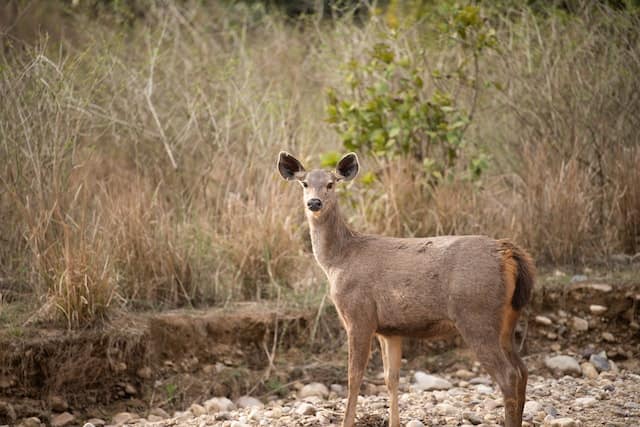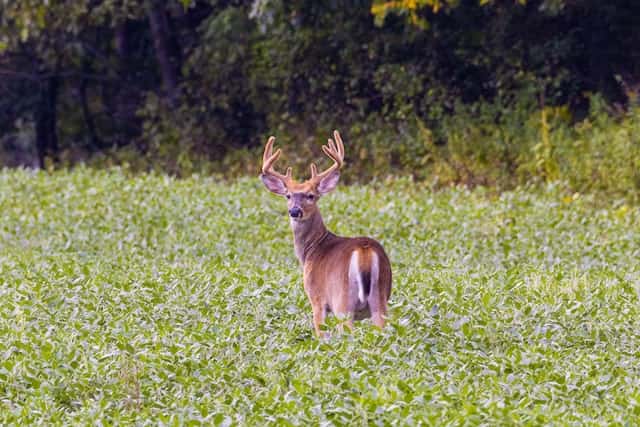How do you differentiate a doe from a buck? What are the major differences between a doe and a buck (doe vs buck)?
A doe is the female deer, while a buck refers to the male deer. Naturally, male and female animals have different physical traits, with the male having a larger body than the female.
A buck is naturally bigger than a doe. The difference in size is a physical factor in identifying a buck. The male deer “buck” also has antlers, which is absent in a doe.
We will be looking at other major differences between a doe and a buck in this article.
What Is a Doe?
The word “doe” refers to a female deer- It’s also a term used for similar animals such as antelope, reindeer, and goat.
The female deer is called a doe because she will eventually produce offspring.
Does naturally live differently compared to bucks. They take the responsibility of parenting their young, which are known as fawns. Without the parenting and care of the female deer, a fawn will likely not survive in the wild.
Female deer are social animals compared to bucks. Staying in the group with other does sometimes determines the survival of the fawns. Does usually travel in groups.
Bucks are more active and social during mating season. They are ready to breed they start producing testosterone. A buck will try to impress a doe by how large his antlers are.
The buck will also show how strong he is for the doe to choose him as the right partner to mate with.

Also Read: Pug vs Bulldog: Difference and Comparison
What Is a Buck?
A buck refers to a male deer but can also be used to describe a male antelope, sheep, goat, or rabbit. A buck is larger than a doe, with its antlers mostly used for fighting other bucks for the right of mating.
A buck’s antlers are the main feature that differentiates it from a doe. The antlers are made of bone and it’s absent in a doe.
Their antlers are used for fighting over mating rights with a doe. They can also be used to defend themselves against predators in the wild such as wolves, foxes, or bears.
Doe vs Buck: Difference between a Doe and a Buck
One of the major differences between a doe and a buck is in their tracks.
While a doe has a more pointed track, a buck has a wider track. A buck has a swaggering gait when moving which a doe doesn’t have. Bucks are also likely to drag their feet across the ground, while does pick up their feet when moving.
So a doe’s track is more orderly than that of a buck.
Bucks are also more observant when foraging for food. They usually walk in front to observe the area before grazing. While the bucks are grazing, the does and fawns walk behind the protective circle.
A buck has a shorter snout and neck compared to a doe. The adult doe has a rounded head in between its ears, whereas a buck has a flat-shaped head between its ears.
Let’s explore more differences between a doe vs a buck.

Also Read: Lycan vs Werewolf: Difference and Comparison
Genders
Naturally, a buck is larger than a doe and that is one of the main physical features that differentiates a buck from a doe. The males are always larger in size than the females, especially with their horns or antlers.
There are also other physical features that help in identifying a male and a female animal. For most species of deer, the doe has a longer neck than the buck.
Antlers
A buck’s antler is the main physical feature that differentiates it from a doe. The antlers are made of bone and it’s absent in a doe.
Their antlers are used during mating season to fight off other male deer. It’s part of their body that can also be used to defend themselves against any threat in the wild.
It’s easy to identify a buck even from meters away because of their antlers.
Size
Another difference between a doe and a buck is their size. Naturally, male animals are always larger than the female.
The size of a doe is smaller compared to that of a buck. A buck’s antler is arguably a factor that makes it larger than a doe.
Seasonal Change
One of the major differences between a doe and a buck is that the male deer usually changes its coat in different seasons.
When it’s winter, the buck usually have redder coats and white patches on their tail. Bucks will also shed their antlers in winter to grow new ones during spring.
Colour
Another difference between a doe and a buck is their colour.
While a doe naturally has brownish-grey fur, a buck’s fur is more of a reddish-brown colour.
Additionally, one of the differences between a doe and a buck is how they urinate. If you are trailing a deer and there is a long trail of urine on the ground, it is likely to be a buck because they urinate while walking.
On the other hand, does only squat to urinate.
Also Read: Cockroach vs Beetle: Difference and Comparison
Doe vs Buck: Comparison Table
| Doe | Buck | |
| Description | The female deer is called a doe because she will eventually produce offspring. | A buck refers to a male deer that is larger than a doe, with its antlers mostly used for fighting other bucks for the right of mating. |
| Antlers | There are no alters, so it’s easy to identify does | Bucks have antlers which they shed during winter and regrow new ones during spring |
| Social behaviour | Does are social animals compared to bucks. | Bucks naturally live alone but only become more active and social during mating season. |
| Parenting | They take the responsibility of parenting their young, which are known as fawns. | They do not participate in raising their fawns. |
| Physical traits | A doe usually urinates by keeping a squat posture. If you notice a spot that smells of urine, it’s a trail of a doe. | Bucks are known to have smaller snout and flatheads. |
| Identification | A doe usually urinate by keeping a squat posture. If you notice a spot that smells of urine, it’s a trail of a doe. | On the other hand, If you are trailing a deer and there is a long trail of urine on the ground, it’s likely to be a buck because they urinate while walking |
Doe vs Buck: What Female, Male, and Offspring are Called in Different Species
Doe
| Term for females | Species |
| Doe | Brocket deer, Fallow deer, Mule deer, Muntjac, Roe deer, Tufted deer, Water deer, White-tail deer, Spotted deer. |
| Hind | Red deer, Moose, Sambar |
| Cow | Elk, Moose, Reindeer |
Buck
| Term for males | Species |
| Buck | Brocket deer, Fallow deer, Mule deer, Musk deer, Roe deer (roebuck), Tufted deer, Water deer, White-tailed deer. |
| Stag | Brocket deer, Red deer, Sambar, Spotted deer, White-tailed deer |
| Bull | Elk, Moose, Reindeer |
Also Read: Lice vs Tick: Difference and Comparison
Offspring
| Terms for offspring | Species |
| Calf | Elk, Moose, Reindeer |
| Fawn | Brocket deer, Fallow deer, Mule deer, Muntjac, Musk deer, Roe deer, Spotted deer, Tufted deer, Water deer, Red deer, White-tailed deer |
Conclusion
Does naturally live differently compared to bucks. They take the responsibility of parenting their young, which are known as fawns. Bucks are more active and social during mating season.
Adult bucks are easy to identify with their wide antlers, shorter snout and neck. They shed their antlers during winter and there is a change in colour as they appear to have redder coats and white patches on their tail.
Does are responsible for nurturing the fawns growing up in the bevy.
Recommendations
- Slug vs Snail: Difference and Comparison
- Hill vs Mountain: Difference vs Comparison
- Cook vs Chef: Difference and Comparison
- Baking vs Roasting: Difference and Comparison
- Cooking vs Baking: Difference and Comparison
References
- A-ZAnimals: Female Deer Name and Behavior Explained
- Askanydifference: Doe vs Buck: Difference and Comparison
- Differenceguru: Difference Between Doe and Buck
- Differencebetween: Difference Between Doe and Buck
- Animals.mom: THE CHARACTERISTICS OF DOE OR FEMALE DEER

Leave a Reply